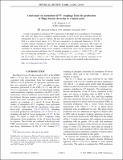Constraints on anomalous H V V couplings from the production of Higgs bosons decaying to τ lepton pairs
Author(s)
The CMS Collaboration
DownloadPublished version (1.546Mb)
Publisher Policy
Publisher Policy
Article is made available in accordance with the publisher's policy and may be subject to US copyright law. Please refer to the publisher's site for terms of use.
Terms of use
Metadata
Show full item recordAbstract
© 2019 CERN. for the CMS Collaboration. Published by the American Physical Society under the terms of the "https://creativecommons.org/licenses/by/4.0/" Creative Commons Attribution 4.0 International license. Further distribution of this work must maintain attribution to the author(s) and the published article's title, journal citation, and DOI. A study is presented of anomalous HVV interactions of the Higgs boson, including its CP properties. The study uses Higgs boson candidates produced mainly in vector boson fusion and gluon fusion that subsequently decay to a pair of τ leptons. The data were recorded by the CMS experiment at the LHC in 2016 at a center-of-mass energy of 13 TeV and correspond to an integrated luminosity of 35.9 fb-1. A matrix element technique is employed for the analysis of anomalous interactions. The results are combined with those from the H→4â.," decay channel presented earlier, yielding the most stringent constraints on anomalous Higgs boson couplings to electroweak vector bosons expressed as effective cross section fractions and phases: The CP-violating parameter fa3cos(φa3)=(0.00±0.27)×10-3 and the CP-conserving parameters fa2cos(φa2)=(0.08-0.21+1.04)×10-3, fΛ1cos(φΛ1)=(0.00-0.09+0.53)×10-3, and fΛ1Zγcos(φΛ1Zγ)=(0.0-1.3+1.1)×10-3. The current dataset does not allow for precise constraints on CP properties in the gluon fusion process. The results are consistent with standard model expectations.
Date issued
2019Department
Massachusetts Institute of Technology. Department of Physics; Massachusetts Institute of Technology. Laboratory for Nuclear ScienceJournal
Physical Review D
Publisher
American Physical Society (APS)